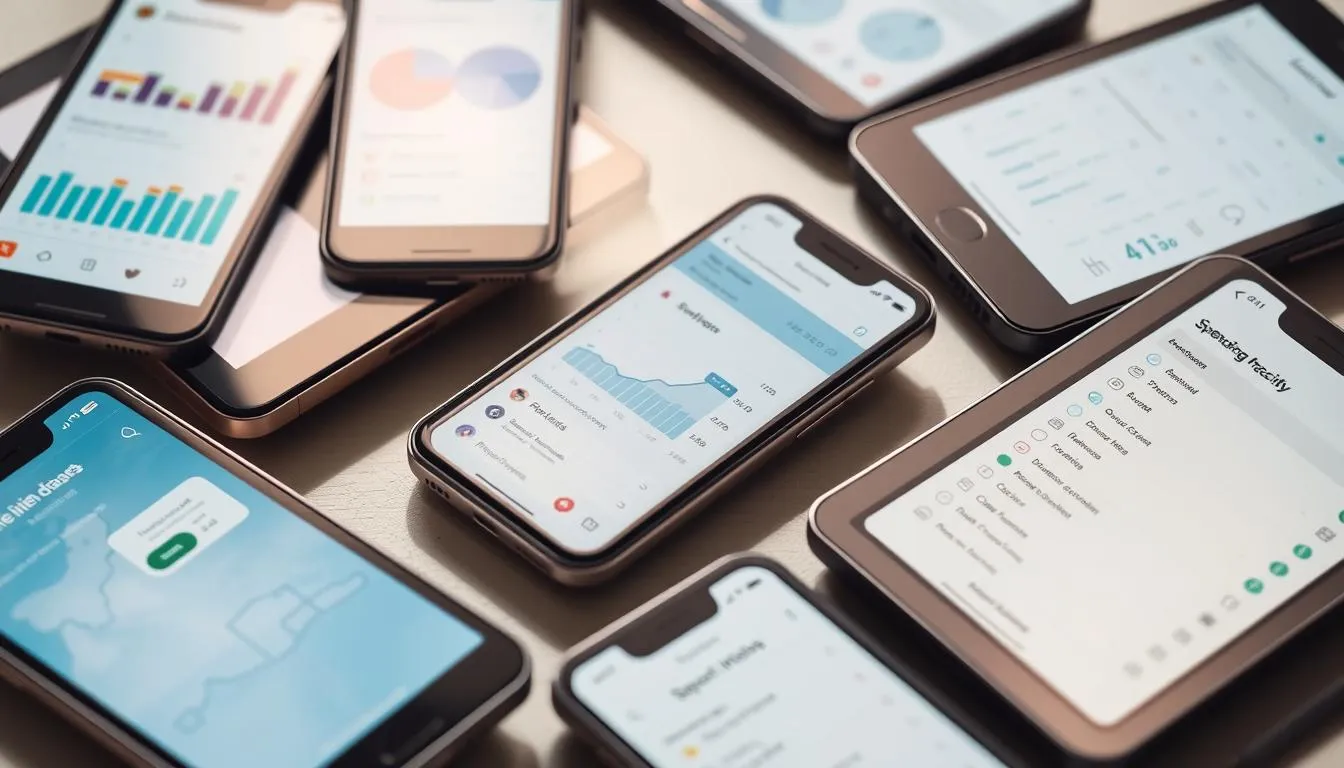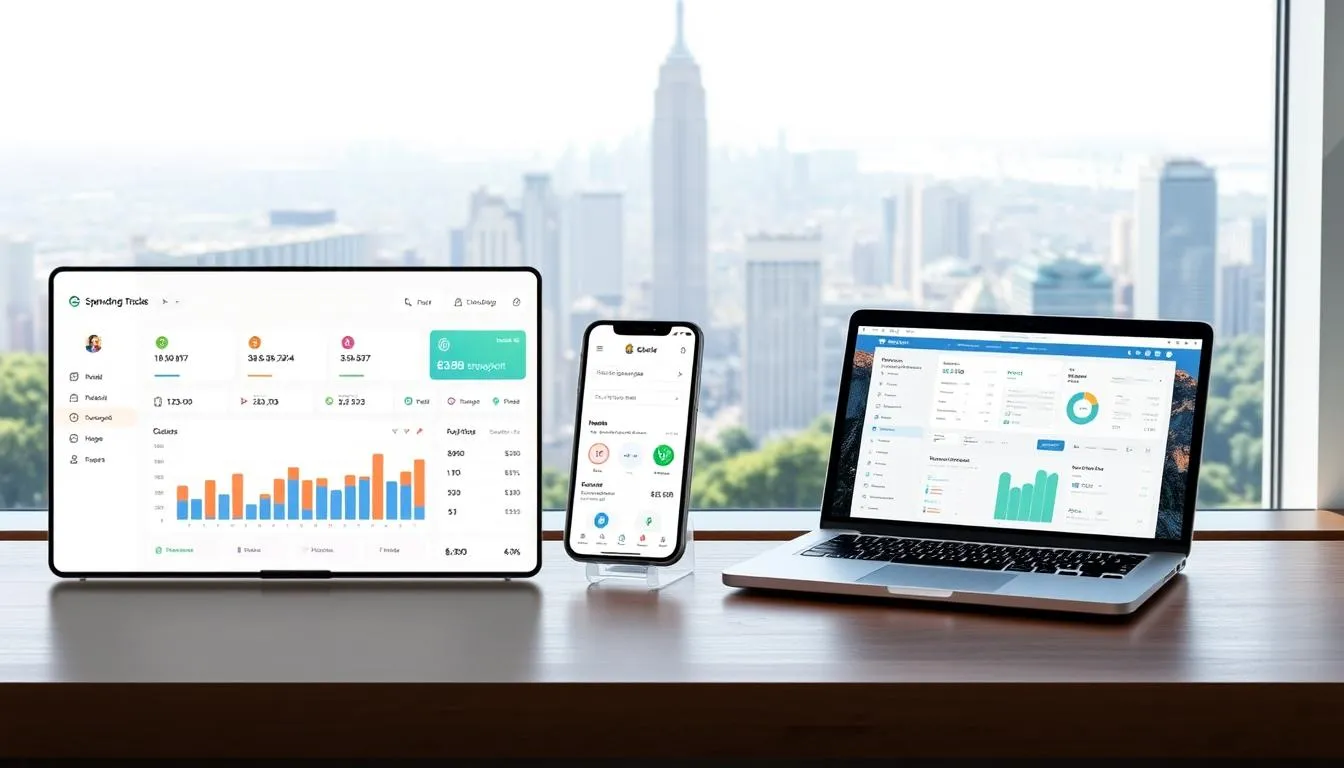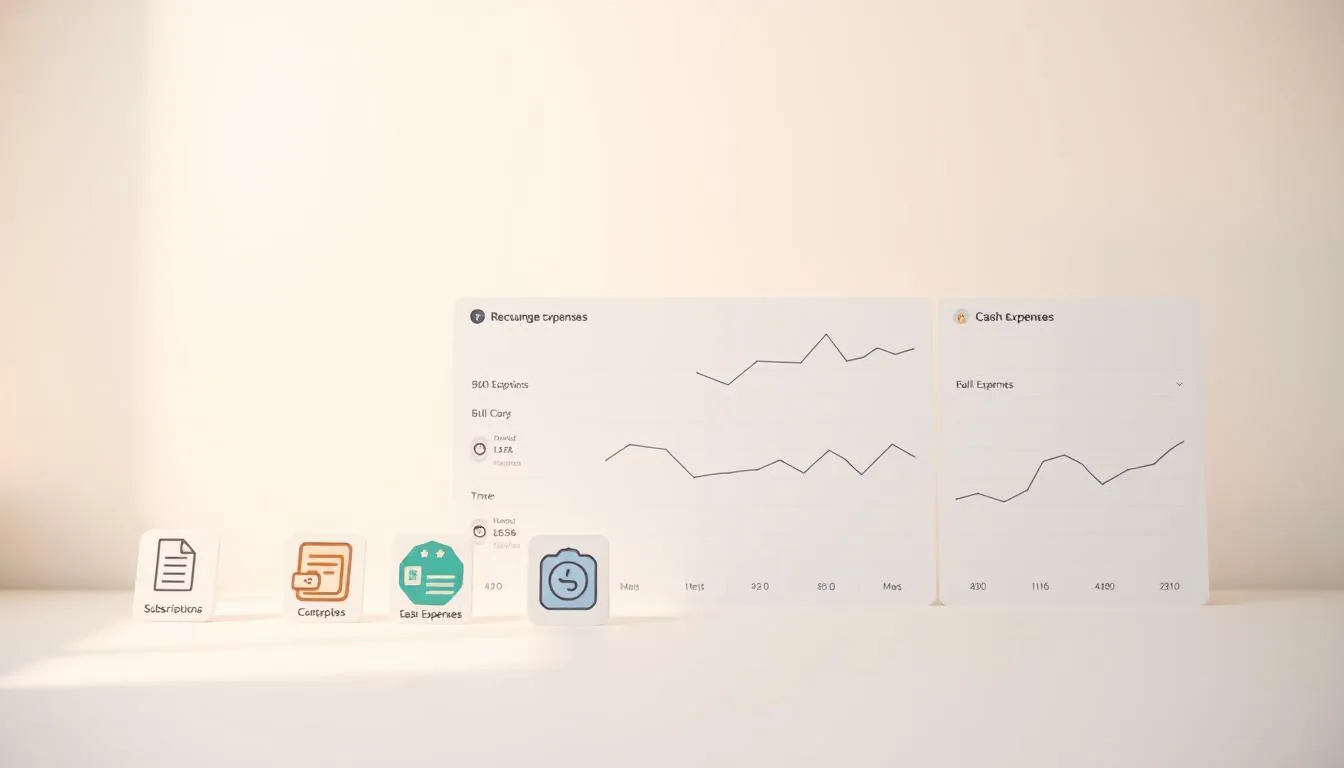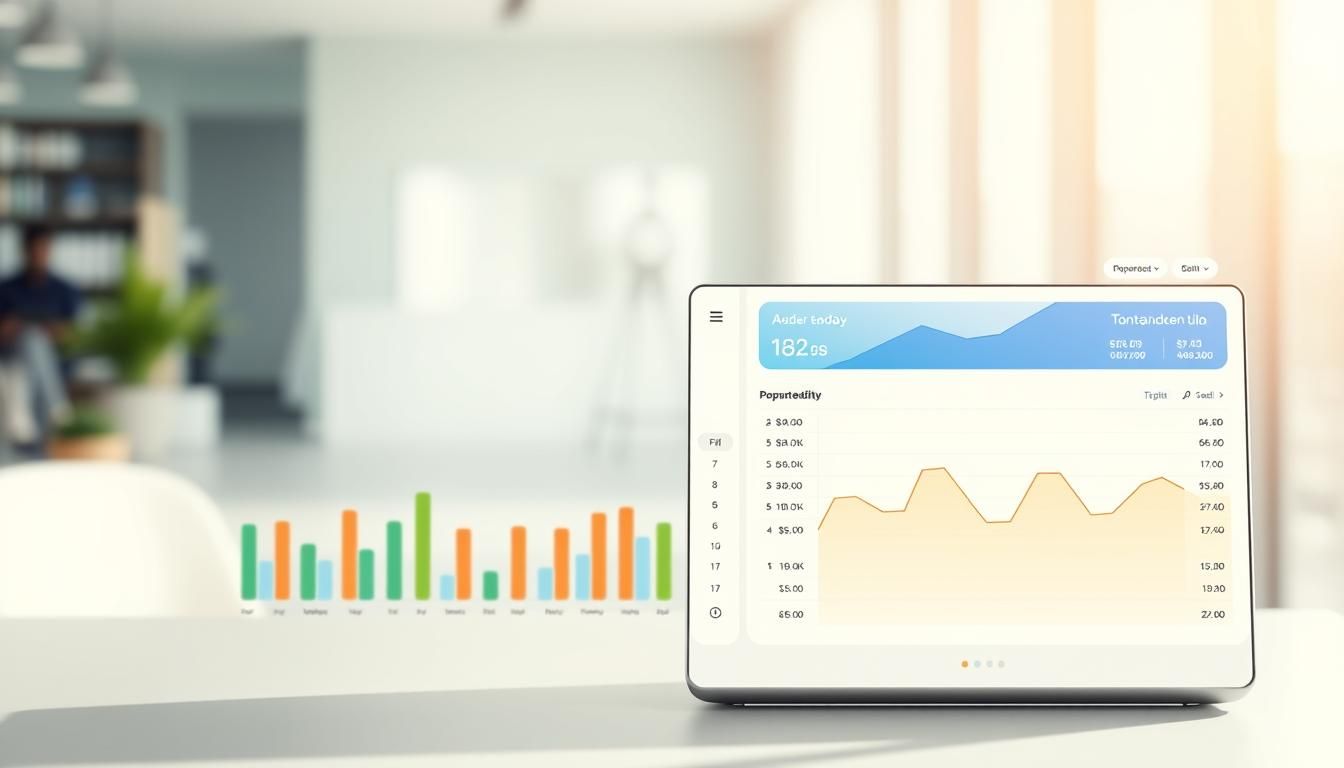Nearly half of adults admit they lose track of small purchases each month — and those micro-buys add up fast. That gap is why a simple tool can change how you manage everyday money.
This quick overview shows how two top apps make daily finance easier. One provides a free core with easy entry, flexible time views, Budget Mode with carryover, editable categories, and a one-time Pro upgrade for exports and backups.
The other brings Apple-native polish: automated categorization, unified dashboards for accounts and investments, recurring detection, and a subscription model with a free trial.
Expect plain‑English guidance on features that affect daily choices — from fast transaction entry to smart alerts — and a clear look at price and privacy so you can pick the right fit.
Try the simple, well-rated option on Google Play if you want a fast start: Spending Tracker on Google Play.
Key Takeaways
- Small, frequent tracking habits reveal big savings opportunities.
- A free core app can be enough; Pro upgrades add export and sync features.
- Apple-native tools offer deeper account and net worth views for a fee.
- Look for quick entry, repeat transactions, and clear summaries.
- Compare price models and privacy promises before deciding.
Why a spending tracker matters right now
A simple daily log can reveal small habits that erode your savings each month.
Start early: the sooner you track spending, the faster you spot subscriptions, impulse buys, or tiny fees that add up.
A reliable routine saves time. Quick entry and clear summaries cut mental load so you manage money without stress.
“Copilot made managing finances enjoyable after switching from Mint — clean design, fast feature rollouts, and a dashboard that shows everything at a glance.”
Shared visibility matters. Users report that Dropbox sync and shared accounts keep couples aligned and prevent surprise balance gaps.
- Contextual views (by category or period) replace spreadsheets for most daily choices.
- Automated insights expose recurring costs and nudge better habits.
- Seeing progress over a month makes trimming costs and boosting savings simpler.
| Benefit | Spending Tracker | Copilot Money |
|---|---|---|
| Simplicity | Fast manual entry, minimal taps | Clean UI with smart defaults |
| Shared use | Dropbox sync for partners | Account consolidation for households |
| Insights | Basic summaries | Automated categorization and dashboards |
Want practical steps? Read how to track monthly expenses for quick wins you can apply today.
How we chose the best apps to track spending
We tested apps with one goal: make daily money management faster and less annoying. That meant checking real-world speed, clarity of reports, and whether core tools let you act without extra steps.

Core features that actually save you time
Fast entry, flexible time ranges, and smart automation topped our list. We favored apps that let you set repeat entries, apply rules, and get quick summaries.
Practical additions like reminders, Dropbox sync, and easy export were weighted heavily. These cut friction so daily logging becomes a habit, not a chore.
Pricing, upgrades, and long-term value
Price models matter. We compared one-time Pro upgrades to an annual subscription to judge lifetime cost.
For example, a free core with a single pro purchase can be cheaper long-term for casual users. Subscriptions may suit people who want continual feature updates and support.
Privacy practices and data handling
Privacy was part of the score. We reviewed each app’s privacy policy and what data they collect.
One developer states identifiers and diagnostics may be gathered but not linked to identity. The other commits to treating financial data responsibly. App support privacy and clear documentation improved an app’s rating.
- We prioritized features that cut daily effort: fast entry, clear reports, and automation.
- We tested reliability and how quickly teams respond to user feedback and support requests.
- We judged privacy by policies, what data is stored, and how well teams explain those choices.
Top spending tracker apps in the United States today
One app keeps things minimal and fast; the other automates and unifies your accounts.
Spending Tracker (MH Riley Ltd) centers on quick logging, flexible periods, and a Budget Mode with carryover. Long-time users praise Dropbox sync for shared views and consistent use over years. A one-time Pro upgrade adds exports and repeat transactions, so the app stays simple without a subscription.
Copilot Money
Copilot adds a personalized categorization engine, Recurrings detection, and an all-accounts dashboard that includes investments and net worth. If you use an iPhone or other Apple devices, Copilot’s native design, Face ID, widgets, and dark mode make it feel integrated.
- Quick basics: fast transaction entry and clear summaries with Spending Tracker.
- Automation: Copilot learns categories, applies rules, and surfaces insights.
- Choose based on whether you want a low‑cost, minimal app or a premium, automated experience across devices.
Spending Tracker app overview
Spending Tracker by MH Riley Ltd focuses on fast entry, clear summaries, and flexible views so you can review and plan in minutes.

Pick a time frame that fits your routine.
Flexible time periods
Choose weekly, monthly, or yearly views to match how you plan. Swipe through past and future periods in the Summary View to spot trends and gaps.
Budget Mode with carryover
Turn on Budget Mode to set a fixed budget and carry leftover funds into the next period. This approach keeps momentum and avoids the reset effect that kills progress.
Categories, reports, and export
Create editable categories with icons, then open interactive charts to see which areas drive most of your costs.
Power users can add repeat transactions and export data — note the repeat and export features are pro upgrade required.
Sync, reminders, and a one-time pro model
Sync via Dropbox to keep multiple accounts aligned across devices. Add reminders, enable a passcode, and rely on auto-backup for safety.
The app uses a one-time pro purchase rather than a subscription, so you get long-term value without recurring fees.
| Feature | What it does | Why it helps |
|---|---|---|
| Time views | Weekly / Monthly / Yearly | See short and long-term trends at a glance |
| Budget Mode | Carryover between periods | Keeps motivation and smooths progress |
| Categories & reports | Editable categories; interactive charts | Pinpoint where money goes and prepare taxes |
| Sync & backup | Dropbox sync, passcode, auto-backup | Shared access and data safety without subscriptions |
If you need help, visit the app’s website app support for setup guides and troubleshooting.
Copilot Money app overview
Copilot Money blends automated insights with hands-on controls so you can manage cash and investments from one place.
Personalized categorization that learns from you
Copilot’s categories improve as you review entries. When you correct a category, the app creates rules that auto-apply to future transactions.
Budgets with rollovers and monthly summaries
Budgets include rollovers so you keep momentum month to month. Monthly income and expense summaries show whether you are ahead or behind your plan.
Recurrings to spot price hikes
The recurrings view centralizes subscriptions and regular bills. It flags price changes so you can act before costs snowball.
All accounts, investments, and net worth
Bring checking, credit, savings, and investment accounts into a single dashboard. Net worth updates and live performance estimates keep long‑term goals visible.
Apple-native on iPhone, iPad, and Mac
The Apple-native design includes Face ID, widgets, and dark mode for quick check-ins. You can drill into a transaction to see Amazon or Venmo details, edit entries, and run bulk actions for faster cleanup.
- Data stance: Copilot promises responsible handling and no ads or hidden fees.
- Try before you commit: start with a free trial, then opt into yearly pricing if it fits.
- Support: in-app help and documentation guide setup and imports.
Feature-by-feature comparison for tracking expenses
See which features speed up common tasks and which ones add useful automation. This quick guide compares entry, organization, reports, sync, and extras so you can pick the top fit for your routine.

Transaction entry, rules, and bulk actions
Entry speed: One app favors rapid manual input for fast logs. The other layers in rules and bulk actions to auto-classify future items.
Categories and custom groups
Categories: Both let you edit and group categories. One keeps visuals simple with icons. The other suggests smart groups and automates tagging.
Reports, charts, and cash flow views
Interactive charts make short trends clear. The automated option adds cohesive cash-flow and month summaries for bigger-picture planning.
Sync and cross-device support
Accounts: One app mirrors data via Dropbox for shared access. The other syncs linked accounts across iPhone, iPad, and Mac in real time.
Extras: exports, Amazon/Venmo details, property value, and more
Exports and repeat entries arrive with a one-time Pro upgrade. The advanced app adds Amazon/Venmo details, property and investment views, and live estimates.
| Area | Minimal manual app | Automated assistant |
|---|---|---|
| Entry | Fast manual input | Rules + bulk actions |
| Categories | Editable icons | Smart suggestions & groups |
| Reports | Interactive charts | Cash-flow & monthly summaries |
| Sync | Dropbox mirror | Real-time account sync |
| Extras | Exports by date/category | Amazon/Venmo details, investments |
Pricing and value: free, one-time pro upgrade, or subscription
Cost structure matters as much as features when you pick a daily finance app. Think about how often you’ll use it each month and whether you prefer a one-off payment or ongoing updates.
Spending Tracker: free core with a one-time Pro upgrade
The core version is free and covers quick entry, summaries, and basic categories. A pro upgrade unlocks repeat transactions and export and is a one-time purchase — no subscription required.
Copilot Money: trial then yearly plan
Copilot offers a free trial and then bills $95 yearly. The subscription supports automated rules, account aggregation, and regular feature updates with no ads or hidden fees.
Which model fits different budgets and time horizons
If you want to minimize ongoing costs, a free core plus a single pro purchase keeps long-term bills low.
- Manual-first users: one-time upgrades often give the best value for lightly used apps.
- Heavy automation: a yearly subscription can pay for itself if it saves you time and consolidates accounts.
- Freelancers: exports and category reports from a pro version can simplify taxes without recurring fees.
| Model | What you pay | Good for |
|---|---|---|
| One-time Pro | Single purchase | Long-term, low-cost use |
| Yearly subscription | $95 / year | Active users who want automation |
Try before you commit: both apps let you test — a free core and a trial — so you can judge long-term value and total cost of ownership over a year.
Privacy and data: what the apps collect and how they use it
Before you sync accounts, it’s worth knowing what data the app collects and why. That helps you weigh trade-offs between convenience and control.
Spending Tracker (MH Riley Ltd)
MH Riley Ltd discloses that identifiers, usage data, and diagnostics may be collected. The developer says this information is not linked to your identity.
Privacy practices may vary depending on which features you use and how you enable sync or backups. Review the app support privacy notes in the app and the full privacy policy before you enable sharing.
Copilot Money
Copilot publicly commits to treating personal and financial data responsibly. The company says there are no ads or hidden fees and that data use aims to power automation and insights.
“Copilot balances automation with safeguards so account aggregation and investment views work without selling your data.”
- What to compare: what each app collects, whether data is linked to identity, and why the app needs it.
- Read the privacy policy and in-app disclosures so you understand the following data may be used for sync, diagnostics, or features.
- If you prefer minimal sharing, a manual-first app may align better. If you want automation, expect broader access for account aggregation and insights.
- Note device requirements: some features or apps require iOS 13.0 or 13.0 later for full functionality.
Make privacy part of your decision alongside features and price so the app you choose fits both your money goals and comfort level.
Which spending tracker is best for you
Deciding which app fits you depends on how much automation you want and who else will use it.
Families and couples who want simple shared tracking
Choose the minimal app if you want fast, shared entry. Users report seamless sync via Dropbox so an expense entered on one phone appears on the other quickly.
Why it helps: easy category organization and clear summaries keep household budgeting painless.
Freelancers and self-employed users who export by category
Freelancers who need exports for taxes will like Pro features that export by category or date ranges.
Use exports to align categories with Schedule C and reduce prep time at tax season.
Former Mint users seeking automation and modern UX
If you miss Mint’s automations, the automated app offers rules, learning categorization, and a smooth switch for longtime power users.
It groups accounts and shows recurring charges so you catch price changes early.
iPhone, iPad, and Mac users who want an Apple-native app
Deep Apple users get a polished experience with Face ID, widgets, and unified dashboards that include investments and net worth.
Tip: if consolidating accounts and live estimates matters, the Apple-native option brings your finances into one place.
| User type | Best fit | Key benefit |
|---|---|---|
| Couples / Families | Minimal app with Dropbox | Shared entries reflect on both phones |
| Freelancers | Pro with exports | Category-level exports for taxes |
| Former Mint users | Automated assistant | Rules, automation, modern UX |
| Apple device users | Apple-native app | Face ID, widgets, unified accounts |
Ultimately, pick the app that matches how you log expenses: manual simplicity or automated assistance so you actually keep using it.
Tips to track spending consistently and get results
A few simple routines keep your money choices clear and consistent. Make steps small so you stick with them over time and see real savings over years.
Set a realistic budget and enable carryover
Start with a budget you can keep. Use Budget Mode or rollovers so leftover cash moves forward instead of vanishing at period end.
Create clear categories aligned to goals or taxes
Keep categories broad and practical. Editable icons and simple groups cut friction and make exports easier during tax season.
Review recurrings monthly to catch price changes
Check Recurrings or repeating entries once a month. Spotting a price hike early prevents surprise charges and keeps your plan truthful.
- Do a 10-minute weekly check-in. Consistent touch beats deep, infrequent reviews.
- Log purchases in real time. The closer to the purchase, the more accurate your view.
- Use visual summaries to spot trends and adjust quickly.
- Give yourself kind, practical feedback so small course corrections add up.
“Small tweaks each week compound into major wins over years.”
Conclusion
The right tool makes logging transactions painless and progress visible.
Spending Tracker delivers a free core with flexible time views, Budget Mode carryover, Dropbox sync, and a one-time pro upgrade for repeats and exports. It’s simple, reliable, and built for shared use.
Copilot Money adds smart categorization, Recurrings, rollovers, and consolidated accounts and investments. It starts with a free trial and then moves to a $95 yearly subscription for continuous automation and Apple-native polish on iPhone, iPad, and Mac.
Compare features, price, and privacy. Choose the workflow you’ll use week after week, start small, log consistently, and let those steady changes improve your finances over years.
FAQ
What is the difference between the two apps highlighted?
The first app focuses on a simple, no-frills experience with a free core and an optional one-time Pro upgrade for extra features. The second — Copilot Money — emphasizes automated categorization, cross-device Apple-native design, and fuller account aggregation, with a free trial followed by an annual subscription.
Do these apps support multiple time periods like weekly or yearly views?
Yes. Both offer flexible time ranges so you can view transactions and summaries by week, month, or year, helping you spot trends and plan ahead.
Can I set budgets and carry over unused amounts?
Yes. Each app supports budget modes that include carryover and summary views, letting you roll unused funds to the next period and track progress at a glance.
How do categories and custom groups work?
You can create and edit categories, group related expenses, and assign transactions manually. Copilot learns from your feedback to improve categorization automatically.
Is account syncing and cross-device support available?
Yes. Copilot provides cloud sync across iPhone, iPad, and Mac with features like Face ID and widgets. The other app offers Dropbox sync for transfers between devices and manual backups.
What export options exist for reports and data?
Pro or premium tiers unlock exports such as CSV and detailed reports. These let freelancers and small-business users export by category for taxes or bookkeeping.
How do the apps handle recurring transactions and subscriptions?
Both include recurring transaction tools. They highlight price increases and upcoming charges so you can manage subscriptions before they become costly.
What payment models are available and which fits my budget?
One app uses a free core with a one-time Pro upgrade and no subscription. Copilot uses a free trial then an annual fee (around $95/year). Choose one-time upgrade for long-term value or subscription for ongoing updates and advanced automation.
Are there differences in privacy and data collection?
Yes. The simpler app collects basic identifiers, usage, and diagnostics and offers a privacy policy detailing data handling. Copilot also publishes privacy practices and focuses on treating financial information responsibly; review each app’s privacy page before connecting accounts.
What platforms require updates or specific OS versions?
The apps are Apple-focused. Some features require iOS 13.0 or later, and Copilot is optimized for iPhone, iPad, and Mac. Check the App Store listing for exact compatibility.
Do these apps support investments and net worth tracking?
Copilot provides investments and net worth dashboards that aggregate accounts. The simpler app centers on cash flow, budgets, and expense reporting, while Pro unlocks more export and reporting tools.
How secure are connections to my bank or accounts?
Both apps rely on secure connections — often via read-only links from trusted aggregators — and follow industry practices for encryption. Always read the developer’s security and privacy statements for details.
Can I use the app without connecting bank accounts?
Absolutely. You can enter transactions manually, use categories, set budgets, and export data without linking external accounts if you prefer greater control over privacy.
Is customer support available if I run into issues?
Yes. Both apps provide developer websites with support pages and contact options. Look for in-app help, FAQ pages, and email support listed on their App Store pages.
Will I lose data when switching devices or upgrading plans?
Normal use of cloud sync or Dropbox backups preserves data across devices. If you rely on a one-time Pro upgrade, ensure you sign in with the same account to restore purchases; exporting before major changes is a good precaution.
Which app is better for families or shared tracking?
The simpler app is great for couples and families who want straightforward shared tracking with manual entry and budgets. Copilot is better if you need automated aggregation across multiple accounts and richer dashboards.
Can freelancers export transactions by category for taxes?
Yes. Both apps support category-based exports in their paid tiers, which makes it easier to prepare reports for taxes or accounting software.
How do I test features before committing to a paid plan?
Use the free core of the one-time-upgrade app to explore basics. Copilot offers a free trial so you can evaluate automated categorization, sync, and premium dashboards before subscribing.
Are widgets, dark mode, and Face ID supported?
Copilot includes Apple-native features like widgets, dark mode, and Face ID. The other app supports standard iOS features and focuses on simplicity; check its App Store notes for the latest UI additions.
